现在完成时及其考点
图片预览

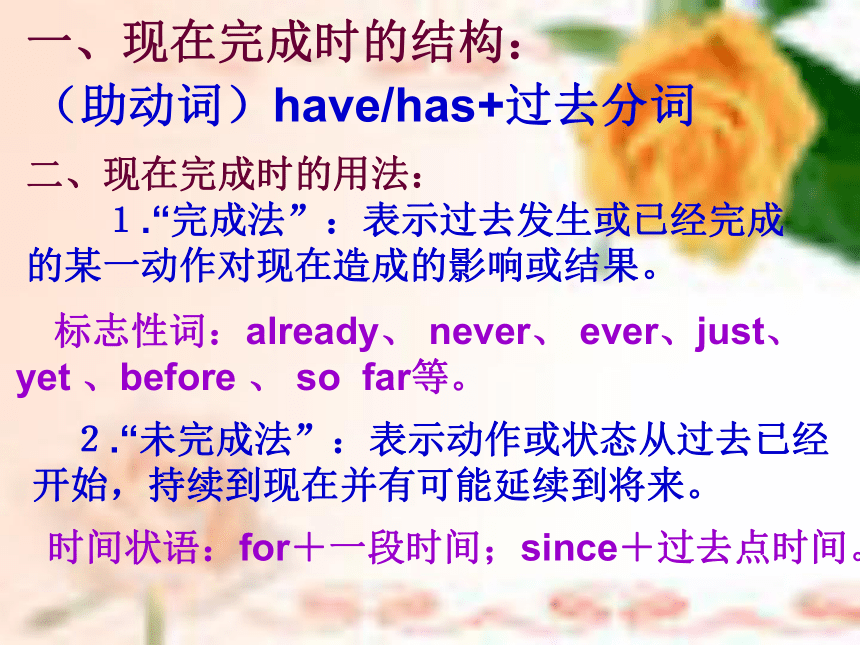
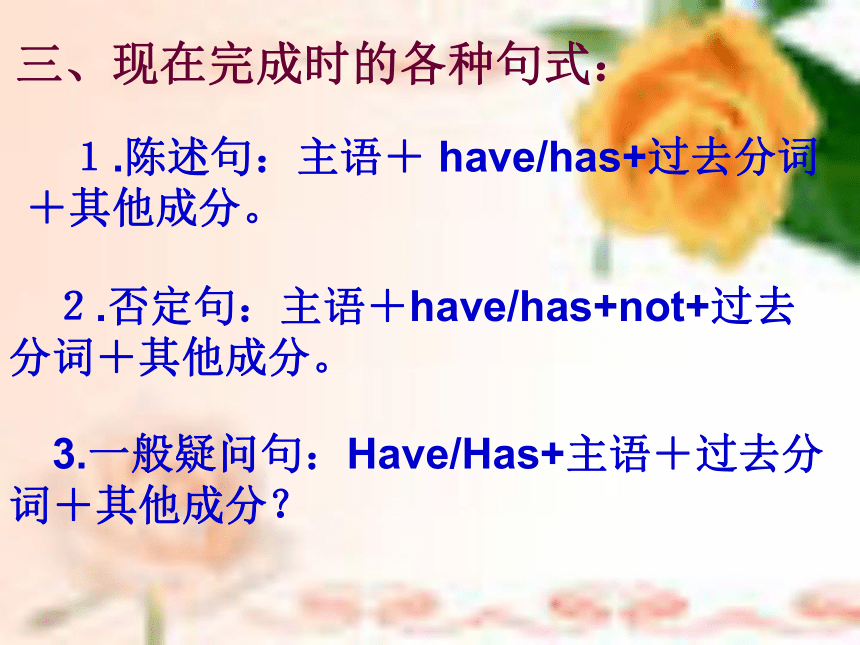
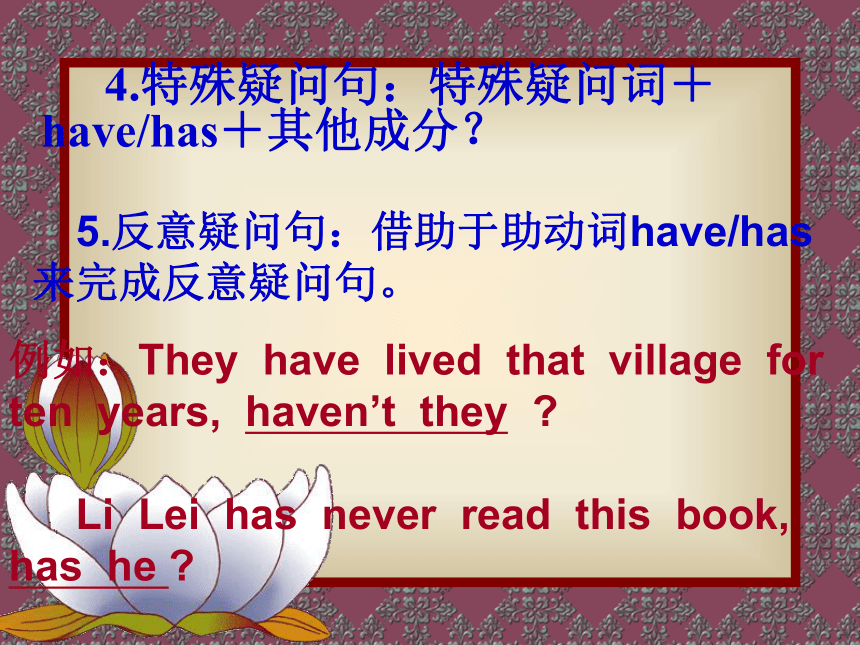
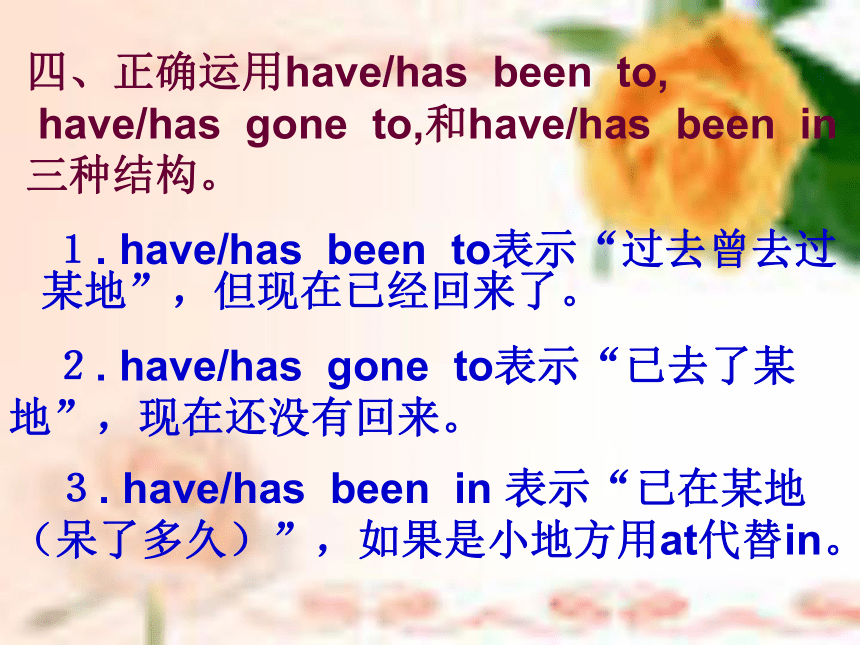
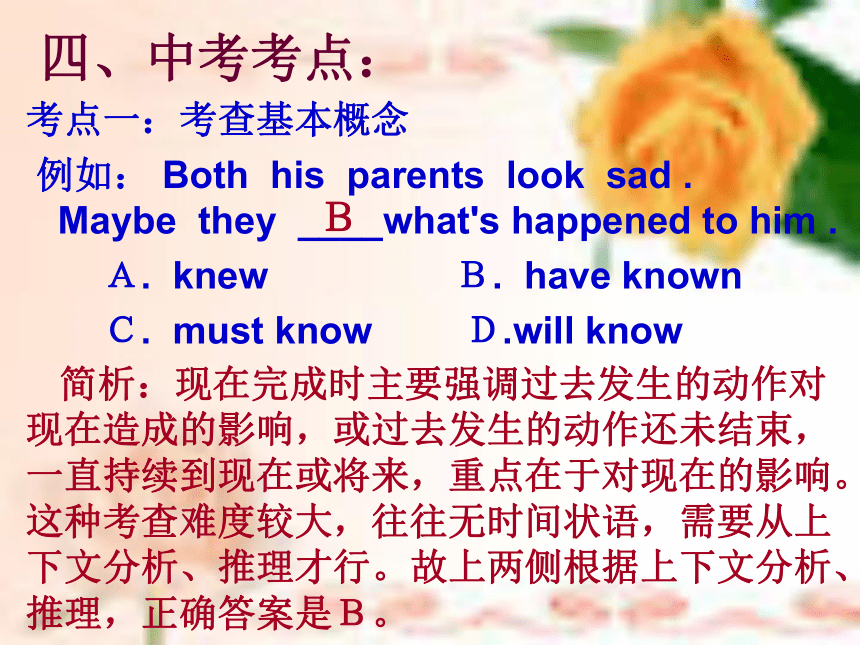
文档简介
课件13张PPT。现在完成时及其考点 大靖初级中学 肖礼一、现在完成时的结构: (助动词)have/has+过去分词二、现在完成时的用法:
1.“完成法”:表示过去发生或已经完成的某一动作对现在造成的影响或结果。 标志性词:already、 never、 ever、just、 yet 、before 、 so far等。 2.“未完成法”:表示动作或状态从过去已经开始,持续到现在并有可能延续到将来。 时间状语:for+一段时间;since+过去点时间。三、现在完成时的各种句式: 1.陈述句:主语+ have/has+过去分词+其他成分。 2.否定句:主语+have/has+not+过去分词+其他成分。 3.一般疑问句:Have/Has+主语+过去分词+其他成分? 4.特殊疑问句:特殊疑问词+have/has+其他成分?
5.反意疑问句:借助于助动词have/has来完成反意疑问句。
例如:They have lived that village for ten years, haven’t they ?
Li Lei has never read this book, has he ?
四、正确运用have/has been to, have/has gone to,和have/has been in 三种结构。 1. have/has been to表示“过去曾去过某地”,但现在已经回来了。 2. have/has gone to表示“已去了某地”,现在还没有回来。 3. have/has been in 表示“已在某地(呆了多久)”,如果是小地方用at代替in。四、中考考点:考点一:考查基本概念
例如: Both his parents look sad . Maybe they ____what's happened to him .
A. knew B. have known
C. must know D.will know 简析:现在完成时主要强调过去发生的动作对现在造成的影响,或过去发生的动作还未结束,一直持续到现在或将来,重点在于对现在的影响。这种考查难度较大,往往无时间状语,需要从上下文分析、推理才行。故上两侧根据上下文分析、推理,正确答案是B。 B考点二:考查时间状语 例1. He has _______ been to Shanghai , has he ? A. already B.never C.ever D. still 例2. Have you met Mr Li ______? A. just B. ago C.before D. a moment ago 例3. The famous writer ____ one new book in the past two year . A. is writing B.was writing C.wrote D.has written 例4.—Our country ______ a lot so far .
—Yes . I hope it will be even ______ .
A. has changed ; well B. changed ; good
C. has changed ; better D. changed ; better
例5. Zhao Lan ______already ______in this school for two years .
A. was ; studying B. will ; study
C. has ; studied D. are ; studying
例6. We ______ Xiao Li since she was a little girl .
A. know B. had known C. have known D. knew
例7. Harry Potter is a very nice film .I_______ it twice .
A. will see B. have seen C. saw D.seeBCDCCCB 简析:现在完成时的时间状语常有如下四类:
⑴现在完成时常与already(已经),just(刚刚,正好),ever(曾经),never(从来,也不;从不),before(以前),yet(仍然)等连用。
⑵现在完成时常与recently(近来),so far(到目前为止),in the past/“last + 一段时间”等时间状语连用。因为上述短语表示的是从现在起往前推算的一段时间,句中的动作是从过去某一时间或时刻开始持续到现在的。
⑶现在完成时时常与“for +时间段或since +过去时间点”连用(含从句,从句过去时)。
⑷现在完成时还与once(一次),twice(两次),three times(三次),several times(几次)等表示重复次数的词语连用。考点三:考查与一般过去时的区别 例1.—These farmers have been to the United States . —Really ? When ___ there ? A. will they go B. did they go C. do they go D. have they gone 例2.—______ you ___ your homework yet ? —Yes . I _____ it a moment ago . A. Did ; do ; finished B.Have ; done ; finished C. Have ; done ; have finished D. will ; do ; finish 简析:现在完成时与一般过去时容易混淆,就是因为它们所表示的动作都发生在过去,但二者又有区别:一般过去时表示过去某个时间发生的事、存在的状态或经常发生的动作,说话的侧重点在于陈述一件过去的事情,与现在没有关系;现在完成时表示与现在有关系的发生在过去的动作,它不与表示过去的时间状语(如yesterday , last week , a moment ago等)连用。故例1、2的正确答案皆为B。BB考点四:考查非延续性动词的用法 例1. His father ______ the Party since 1978 . A. joined B. has joined C. was in D. has been in 例2.—Do you know him well ? — Sure .We _________ friends since ten years ago . A. were B. have been C. have become D. have made 例3.—How long have you ____ here ? —About two months . A. been B. gone C. come D. arrived 例4. Hurry up! The play __________ for ten minutes .
A. has begun B. had begun C. has been on D. began
例5. His uncle died two years ago .(改变句子,句意不变)
His uncle has ____ __ _ for two years
例6. Her mother has been a Party member for three years .(同义句) Her mother _______ the Party three years ________ .
例7. It _____ ten years since he left the army .
A. is B. has C. will D. wasDBACbeen deadjoined agoA 简析:现在完成时中,非延续性动词不能与for和since引导的表示一段时间的状语连用,通常是用相应的延续性动词来代替。常用的非延续性动词及替代形式如下: close—→be closed, put on→wear , open—→be open get up—→be up, finish/end—→be over , lose—→be lost , marry—→be married(to), get to know—→ know
fall asleep/ go to sleep —→be asleep ( sleep ) ,
come/arrive—→be here/in ,
come/get back—→be back , go/leave-be away , become —→be , borrow —→keep ,
buy—→have , begin/start—→be on ,
die—→be dead ,
join—→be in/be a ember of... ,
catch a cold—→ have a cold等,考点五:考查词组have/has been in / to与have/has gone to的区别 例1. Miss Green isn‘t in the office . she_______ to the library . A.has gone B. went C.will go D. has been 例2. My parents ______ Shandong for ten years . A. have been in B. have been to C. have gone to D.have been 简析:“have/has gone to + 地点”表示“某人去了某地(还未回来)”,指主语所指的人不在这儿。“have/has been in + 地点”表示“在某地呆了多长时间”,常与表示时间的状语连用。“have/has been to +地点”表示“曾经去过某地(但现在已不在那儿)。”故例1、2的正确答案皆为A。AASee you next time!
1.“完成法”:表示过去发生或已经完成的某一动作对现在造成的影响或结果。 标志性词:already、 never、 ever、just、 yet 、before 、 so far等。 2.“未完成法”:表示动作或状态从过去已经开始,持续到现在并有可能延续到将来。 时间状语:for+一段时间;since+过去点时间。三、现在完成时的各种句式: 1.陈述句:主语+ have/has+过去分词+其他成分。 2.否定句:主语+have/has+not+过去分词+其他成分。 3.一般疑问句:Have/Has+主语+过去分词+其他成分? 4.特殊疑问句:特殊疑问词+have/has+其他成分?
5.反意疑问句:借助于助动词have/has来完成反意疑问句。
例如:They have lived that village for ten years, haven’t they ?
Li Lei has never read this book, has he ?
四、正确运用have/has been to, have/has gone to,和have/has been in 三种结构。 1. have/has been to表示“过去曾去过某地”,但现在已经回来了。 2. have/has gone to表示“已去了某地”,现在还没有回来。 3. have/has been in 表示“已在某地(呆了多久)”,如果是小地方用at代替in。四、中考考点:考点一:考查基本概念
例如: Both his parents look sad . Maybe they ____what's happened to him .
A. knew B. have known
C. must know D.will know 简析:现在完成时主要强调过去发生的动作对现在造成的影响,或过去发生的动作还未结束,一直持续到现在或将来,重点在于对现在的影响。这种考查难度较大,往往无时间状语,需要从上下文分析、推理才行。故上两侧根据上下文分析、推理,正确答案是B。 B考点二:考查时间状语 例1. He has _______ been to Shanghai , has he ? A. already B.never C.ever D. still 例2. Have you met Mr Li ______? A. just B. ago C.before D. a moment ago 例3. The famous writer ____ one new book in the past two year . A. is writing B.was writing C.wrote D.has written 例4.—Our country ______ a lot so far .
—Yes . I hope it will be even ______ .
A. has changed ; well B. changed ; good
C. has changed ; better D. changed ; better
例5. Zhao Lan ______already ______in this school for two years .
A. was ; studying B. will ; study
C. has ; studied D. are ; studying
例6. We ______ Xiao Li since she was a little girl .
A. know B. had known C. have known D. knew
例7. Harry Potter is a very nice film .I_______ it twice .
A. will see B. have seen C. saw D.seeBCDCCCB 简析:现在完成时的时间状语常有如下四类:
⑴现在完成时常与already(已经),just(刚刚,正好),ever(曾经),never(从来,也不;从不),before(以前),yet(仍然)等连用。
⑵现在完成时常与recently(近来),so far(到目前为止),in the past/“last + 一段时间”等时间状语连用。因为上述短语表示的是从现在起往前推算的一段时间,句中的动作是从过去某一时间或时刻开始持续到现在的。
⑶现在完成时时常与“for +时间段或since +过去时间点”连用(含从句,从句过去时)。
⑷现在完成时还与once(一次),twice(两次),three times(三次),several times(几次)等表示重复次数的词语连用。考点三:考查与一般过去时的区别 例1.—These farmers have been to the United States . —Really ? When ___ there ? A. will they go B. did they go C. do they go D. have they gone 例2.—______ you ___ your homework yet ? —Yes . I _____ it a moment ago . A. Did ; do ; finished B.Have ; done ; finished C. Have ; done ; have finished D. will ; do ; finish 简析:现在完成时与一般过去时容易混淆,就是因为它们所表示的动作都发生在过去,但二者又有区别:一般过去时表示过去某个时间发生的事、存在的状态或经常发生的动作,说话的侧重点在于陈述一件过去的事情,与现在没有关系;现在完成时表示与现在有关系的发生在过去的动作,它不与表示过去的时间状语(如yesterday , last week , a moment ago等)连用。故例1、2的正确答案皆为B。BB考点四:考查非延续性动词的用法 例1. His father ______ the Party since 1978 . A. joined B. has joined C. was in D. has been in 例2.—Do you know him well ? — Sure .We _________ friends since ten years ago . A. were B. have been C. have become D. have made 例3.—How long have you ____ here ? —About two months . A. been B. gone C. come D. arrived 例4. Hurry up! The play __________ for ten minutes .
A. has begun B. had begun C. has been on D. began
例5. His uncle died two years ago .(改变句子,句意不变)
His uncle has ____ __ _ for two years
例6. Her mother has been a Party member for three years .(同义句) Her mother _______ the Party three years ________ .
例7. It _____ ten years since he left the army .
A. is B. has C. will D. wasDBACbeen deadjoined agoA 简析:现在完成时中,非延续性动词不能与for和since引导的表示一段时间的状语连用,通常是用相应的延续性动词来代替。常用的非延续性动词及替代形式如下: close—→be closed, put on→wear , open—→be open get up—→be up, finish/end—→be over , lose—→be lost , marry—→be married(to), get to know—→ know
fall asleep/ go to sleep —→be asleep ( sleep ) ,
come/arrive—→be here/in ,
come/get back—→be back , go/leave-be away , become —→be , borrow —→keep ,
buy—→have , begin/start—→be on ,
die—→be dead ,
join—→be in/be a ember of... ,
catch a cold—→ have a cold等,考点五:考查词组have/has been in / to与have/has gone to的区别 例1. Miss Green isn‘t in the office . she_______ to the library . A.has gone B. went C.will go D. has been 例2. My parents ______ Shandong for ten years . A. have been in B. have been to C. have gone to D.have been 简析:“have/has gone to + 地点”表示“某人去了某地(还未回来)”,指主语所指的人不在这儿。“have/has been in + 地点”表示“在某地呆了多长时间”,常与表示时间的状语连用。“have/has been to +地点”表示“曾经去过某地(但现在已不在那儿)。”故例1、2的正确答案皆为A。AASee you next time!
同课章节目录
- 词法
- 名词
- 动词和动词短语
- 动词语态
- 动词时态
- 助动词和情态动词
- 非谓语动词
- 冠词
- 代词
- 数词和量词
- 形容词副词及其比较等级
- 介词和介词短语
- 连词和感叹词
- 构词法
- 相似、相近词比较
- 句法
- 陈述句
- 一般疑问句和否定疑问句
- 特殊疑问句及选择疑问句
- 反意疑问句
- 存在句(There be句型)
- 宾语从句
- 定语从句
- 状语从句
- 主谓一致问题
- 简单句
- 并列句
- 复合句
- 主谓一致
- 主、表语从句
- 名词性从句
- 直接引语和间接引语
- 虚拟语气
- 感叹句
- 强调句
- 倒装句
- 祈使句
- 句子的成分
- 句子的分类
- 题型专区
- 单项选择部分
- 易错题
- 完形填空
- 阅读理解
- 词汇练习
- 听说训练
- 句型转换
- 补全对话
- 短文改错
- 翻译
- 书面表达
- 任务型阅读
- 语法填空
- 其他资料
